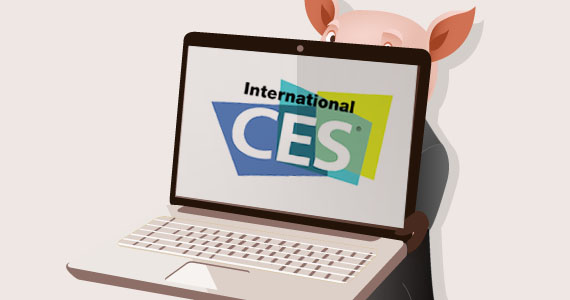The Consumer Electronics Show, that turgid January gadget fest in Las Vegas, has been widely seen in the industry as a great place to show off your wares if you’re not Apple. But is that true? SigFig, the stealth investing startup that’s growing out of stock portfolio manager Wikinvest, has run some numbers on the market performance of the show’s big-company attendees during the event.
The main trend is pretty clear: there’s lots of buying and selling, but no significant gains. And actually, losses are not uncommon.
This data, I should note before getting further, is from SigFig users — a relatively small but statistically significant group of retail investors who use nearly 70 brokerages to handle stock sales and purchases. The overall market data also shows similar big volume changes, but is partially obscured by the large-block trading activities of institutional investors (which in many cases happens for other reasons).
So, in other words, for all the money and time that electronics companies put into the event, they’re not winning many more believers than they’re losing. Maybe it’s just what they’re announcing that isn’t building enough new enthusiasm to drive prices up? Maybe it’s these sorts of data points that helped convince Microsoft to dial down its participation this year?
Now that all the trades have closed from that week, here’s more detail on how this year looked for some top publicly-traded attendees versus previous years.
Intel, which makes semiconductor chips used by many of the electronics companies in attendance, grabs the spotlight every year with a CES keynote about its plans for the future. This year, on keynote day, its stock price jumped a relatively small $0.82 per share — even though shares bought increased by 129% and shares sold also rose by 123% among retail investors on SigFig. Overall, the stock closed down 2.22% by the end of the four-day show. In 2010, meanwhile, the stock ended up 0.48% on top of an 1402% increase in volume, and in 2011 it ended down 0.05% with a 215% increase in volume.
Google, whose Android operating system can be found in more and more devices at the show, has also not seen big gains among SigFig investors. On its biggest day of trading during the show — 90.64% above the average volume — its shares fell by 0.6%. In 2010 it grew by 1.4% during a 374.84% volume increase, and in 2011 it fell by 1.21% with its trading volume at 369.7% above normal.
What about other firms with a big presence at CES?
AT&T’s CES keynote on the 9th mostly failed to register this year, with only minimal volume increase to show — the volume of those buying actually dropped by over 13%, and continued falling during the conference. Verizon, meanwhile, had purchases surge by 1209% (there’s no decimal missing from that number). The price, however, only increased by 0.82%. Both carriers had volume increased around 100% in the past two years, with AT&T losing 2.77% in 2011, and Verizon losing 3.82%.
More analysis is needed to fully understand what’s going on here, like a broader view of all publicly traded companies that have news at the event, over more years. But I have a bit of speculation, following on my earlier point. Maybe CES is really good at generating attention for these companies, but their own announcements are perenially underperforming the hype? If that’s the case, there’s nothing wrong with attending CES, it’s what you bring with you to launch that matters.
By the way, TechCrunch made the CES trek in a big way this year, and generated all sorts of coverage about the events whether it helped the above companies’ stock prices or not. Check out our hub site here for all the details.
